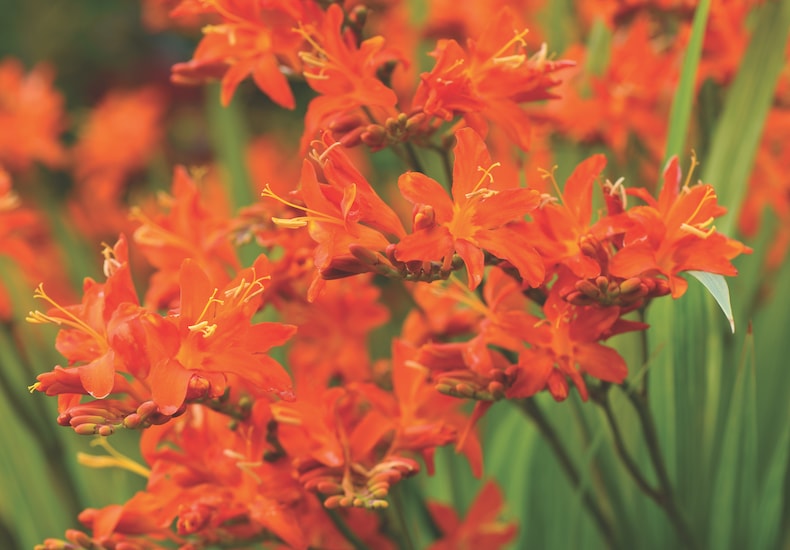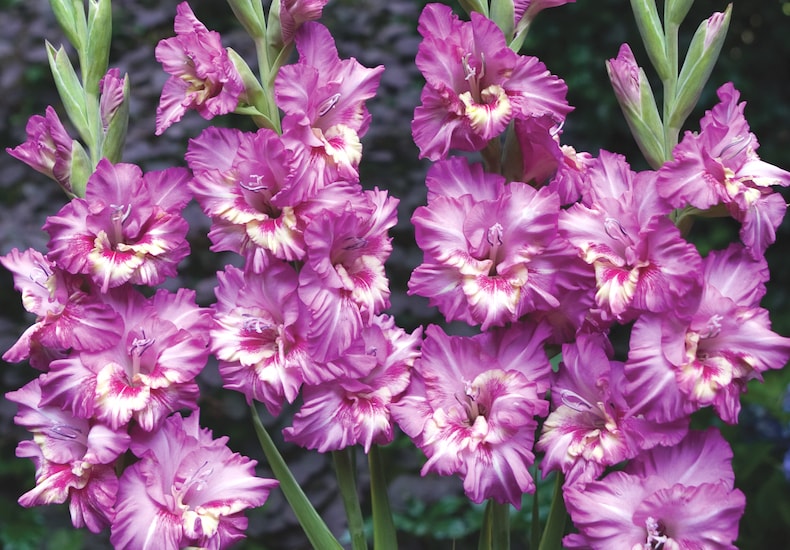Spring is here and it’s the perfect time to get your summer-flowering bulbs and corms in the ground. To help you make the most of these under-rated heroes, we’ve asked experienced gardening bloggers to share their favourite varieties, along with top tips for successful growing. With a little expert advice up your sleeve, your garden will soon be a riot of summer colour!
Including lovely lilies, gorgeous gladioli, and show-stopping swathes of crocosmia, browse our colourful collection of summer-flowering bulbs to inspire your new planting scheme.
Contents:
- Best expert advice on growing lilies
- Best expert advice on growing gladioli
- Best expert advice on growing crocosmia
Best expert advice on growing lilies

Image: Lily Bulbs ‘Tasman’ from Suttons/©Verdegaal
Sporting “large, showy, and often fragrant flowers”, lilies are easy-to-grow perennials that can be planted in autumn or spring. At The Sunday Gardener, Carol Bartlett uses them to make a statement in her borders, but she says they also do well in patio pots – just use free-draining soil and put them in a sunny spot. Read Carol’s full article for a helpful rundown of the main types of lilies.
Alistair of Aberdeen Gardening is a fan of Asiatic lilies and grows two beautiful hybrids in his garden. ‘Pearl Jennifer’ has bright yellow blooms “prominently marked with burgundy spots”, while the flowers of ‘Pearl Stacey’ are a “peachy apricoty soft orange”. Unlike Oriental hybrids, which must be grown in ericaceous (acidic) soil, Asiatic hybrids will grow in neutral to slightly alkaline conditions. Check out Alistair’s article for more tips and tricks.
Over on YouTube, Lee of Project Diaries grows lilies in containers in memory of his Nan. He plants his mixed Asiatic bulbs in a tall pot at two to three times the depth of the bulb, with pebbles at the bottom to stop the plants becoming root-bound. Lilies return year after year, so to guarantee a big and healthy bloom, Lee keeps the bulbs outside through the winter to make sure they have a period of dormancy. Watch his video for more helpful advice.
“Lily flowers must be removed as soon as they fade,” explains Sana of SanaA’s Garden. This ensures the plant puts all its energy into the bulbs rather than making seeds. In her succinct video on how to care for Asiatic lilies after blooming, she demonstrates how she deftly deadheads her lilies and keeps the plants looking tidy. Although it’s a good idea to remove the old flowers, the same can’t be said for the foliage – watch Sana’s video to find out why!
Gardener Roger Crookes waits until October to cut back his containers of summer-flowering lilies. He explains that, “while the leaves are still green, they’re storing energy back down into the bulbs… to give us a nice strong show for next year.” Once the leaves and stems have turned brown, he simply snips the stems near the base – it’s a quick and easy task, as you can see in his video on how to cut back old dead lily stems.
Qualified horticulturalist Ian from DIY Home and Gardening likes to lift the bulbs of his huge tree lilies in early December for winter storage. Having removed as much of the soil and old roots as possible, Ian wraps the bulbs upside down in newspaper. Watch his video for pro tips, including how to check for vine weevil, a bulb-eating pest that likes to overwinter in pots.
Best expert advice on growing gladioli

Image: Gladioli corms ‘Giant Summer Collection’ from Suttons
The tall flower spikes of gladioli are a classic addition to any cottage garden, providing colour and height in beds, borders and containers. Over at Pyracantha, John Moore’s article on how and when to plant gladioli bulbs covers everything from preparing the soil to cutting back your gladioli once they’ve flowered. John plants his gladioli in rows to make it “easier to tend to each plant and subsequently take your cut flowers for indoor displays”. Read his full article for expert tips.
Don’t be put off by the “old-fashioned reputation” of gladioli, says garden designer Rajul Shah at The Small Gardener. If you choose your colours carefully and think about where you’re going to plant them, these “statuesque” plants work wonders in a garden. Rajul staggers the planting of purple, magenta and green varieties over several weeks to get flowers all summer. Check out her gladioli growing article for more secrets to effective garden design.
Although perennial, gladioli do best if protected from the UK winters which is why self-confessed ‘obsessive gardener’ James Middleton recommends lifting and storing the bulbs “at the hint of the first light frosts”. Head over to The Allotment Garden for his step-by-step instructions on storing gladioli over winter ready to plant out next spring. Read James’ full article for tips on how to give them a head start.
Over at @gardening_with_mrshicks, Mrs Hicks didn’t plant her gladioli until June – but, as you can see from her photo, the bulbs didn’t hang about! As a result of the warm weather, this gardener’s borders are already looking colourful thanks to the deep red stems. That’s even before any gladioli flowers have appeared!
Best expert advice on growing crocosmia

Image: Crocosmia ‘Spitfire’ from Suttons/©T&M
If you want bold and beautiful borders, crocosmia produces gorgeous flowers “in all the sunrise colours” from mid to late-summer. Carol Bartlett, aka The Sunday Gardener, recommends staking crocosmia as it can flop over and cover nearby plants if left unchecked. Easy-to-grow and low-maintenance, read Carol’s article on how to grow crocosmia to learn about her favourite varieties and perfect planting partners.
Crocosmia corms “grow in chains, putting on one link a year,” explains The Enduring Gardener in this fascinating crocosmia video. To reinvigorate his Crocosmia ‘Lucifer’, he lifts the corms and splits the chains before replanting in spring. His theory is that the smaller corms, being younger, “will be more vigorous, whereas the older ones have got a bit more in there for storage”. Check out his video to see how deep and far apart to replant them.
If your crocosmia is growing in clumps and not producing many flowers, it’s definitely time to dig them up and split the corms. Andrew and Paul, the growers behind Mad About Gardening, suggest removing the older corms every 3-5 years, which will keep the plants healthy and ensure a good number of flowers each year. Watch their helpful video for the best technique for dividing crocosmia.
Looking for crocosmia planting inspiration? Head over to Instagram where Malcolm and Karen have created a magical path lined with the most striking red crocosmia. Planted amongst mixed grasses and the gentle mauve of nepeta – the effect is absolutely enchanting! Follow them at @panthallcloistergardens for more beautiful garden views.
There’s something very satisfying about growing beautiful flowers from bulbs – they’re certainly worth the wait! We hope our expert bloggers have inspired you to give it a go. Left it a bit late? Choose from our selection of summer bedding plants to brighten up your garden in an instant.
Lead image: Gladioli ‘Tango’ from Suttons
Last Updated on August 19, 2025 by Suttons Horticultural Team





